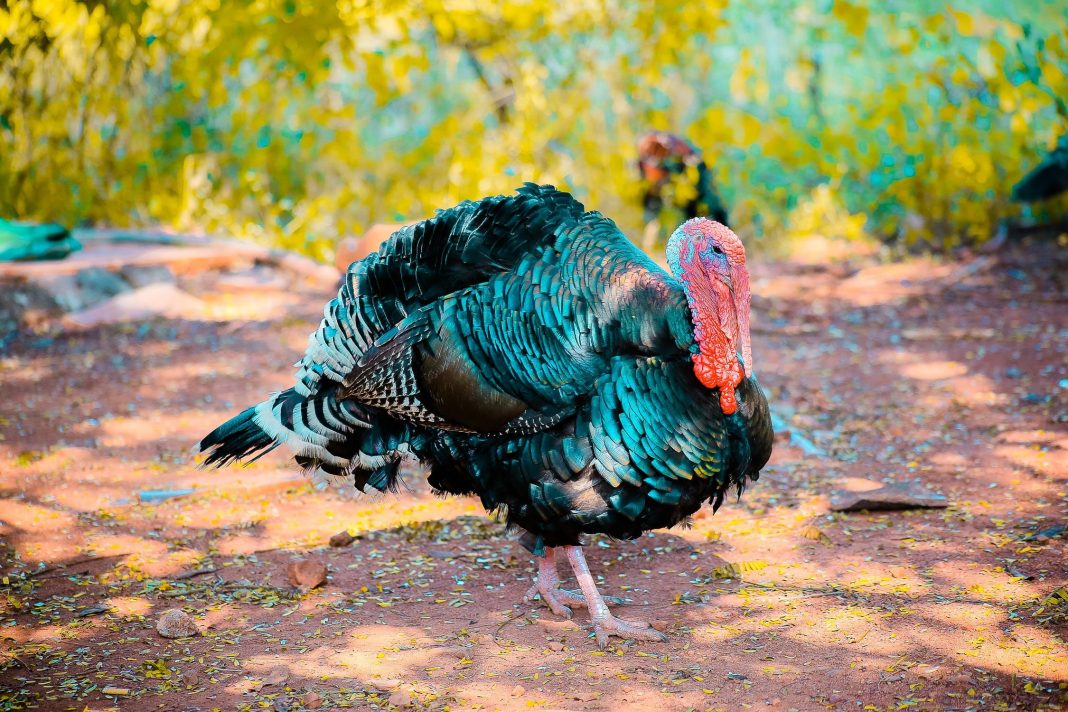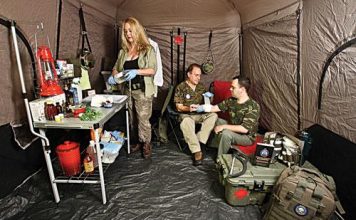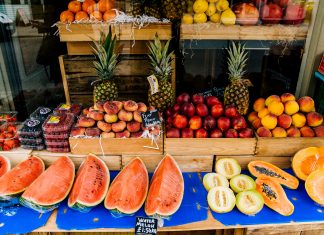 |
|
| Issue #108 • November/December, 2007 |
There are no cultures in the world, nor have there been, that did not have feast days. From prehistoric times to yesterday, food has always played an important part in all holidays. We gather together, family and friends, talk happily, laugh often, and eat! Boy, do we love to eat. And we will celebrate the coming holiday season by cooking up the best homemade meal we can.
For it’s in the celebration of family and giving thanks for a bountiful harvest that we truly come alive. In generations past, the simple things like having a healthy family to gather around the table and being able to set a plentiful table were so much more appreciated than they seem to be today. Now we can eat out for the holidays (but where’s that family celebration?). Or we can buy frozen this or that (but where’s the joy of serving food provided by the sweat of the family’s collective brow?).
I have to tell you a quick story here. We’ve always tried to provide our own turkey or roasting hen for our holiday meals. One we raised and grew ourselves. But one season, we had no turkey so I sighed and bought a frozen one. When I took it out of the oven to serve it, David (then 4) asked if there were any Indians living near us. I said there were. Why? “Well,” he said, his hands on his hips, “one of them shot our turkey with that red arrow!” He was pointing to the little plastic pop-up timer inserted in the breast of the “store turkey!” Being a homesteader from birth, he’d never had anything to do with plastic wrapped frozen turkeys or biscuits and rolls in a tube. Not a bad thing, in my way of thinking. At least we know where our food came from, what it was fed, and how it was cared for.
And let me tell you, if you don’t already know, homegrown or homemade food always tastes so much better than anything you can buy at even the fanciest gourmet shops. But don’t I slave over the stove all day and miss out on enjoying the holiday? Hardly. By a little careful planning, I end up with actually little work to do the day of the feast.
I’m sure your family has its own holiday favorites, but here’s a few ideas from the Clay homestead that your family might enjoy as well.
Planning
The key to a real successful holiday feast is planning, planning, and then more planning. I’m not a list person, being barely organized at all. But I’ve got it sort of figured out so that I can enjoy my family, my company, and a satisfying holiday myself.
|
The week before the holiday meal, mentally go over what you plan on having and hunt around for the ingredients for each recipe. One time I was making last-minute custard pie and couldn’t find the vanilla! Now I mean I had four large bottles in the pantry. Somewhere. Yeah, right. Later that week I found that David had stacked a dozen quarts of home-canned spaghetti sauce in front of them. So make sure you have the ingredients for your meal. If necessary, shop for the ones you lack. This is when a list really helps.
A few days before your feast day, make any cookies you plan on having. By having time to have the kids help you, you will all enjoy making them together, without being rushed. Who cares that they get flour all over the floor and themselves? You have time and by encouraging them to help, you’re building memories that will last for generations. They won’t remember the toys they get for Christmas but will remember the fun you had together making turkey or reindeer cookies.
A day later, make your bars. They are more moist and will be nicer when they are a little fresher than the cookies, which will keep for a long time when kept in a relatively airtight jar. I also make up a fresh baking of bread, saving a loaf and a half for the turkey stuffing. Slightly stale bread is great for stuffing; fresh gets gooey. Homemade is always so much better. (Hint: a batch of rolls makes even better stuffing!)
Two days before the meal, plan on butchering your turkey/roasting bird or begin defrosting that turkey, if you’ve bought one. If it’s a large turkey, over 15 pounds, begin defrosting three days before meal day, in the refrigerator…not on the counter. By butchering the turkey two days before the meal, you have plenty of time to pick it clean, cool it well, and have it ready to stuff.
Two days before your feast, you can also make your Jello mold and cranberry sauce. Both keep nicely in the fridge that long. I also bring my fanciest and most favorite pickles up from the pantry and refrigerate them. Ice cold pickles taste much better and are more crisp than cool ones.
The day before the holiday, make your pumpkin and fruit pies. While these are their very best when baked the day of the meal, they are very good served the next day too and you won’t have to rush so much! We like that, don’t we? I also cook my wild rice so that I only have to heat it up to use in my stuffed squash.
The night before your special day, make sure the frozen turkey is thawing very well. If it seems to be quite frozen still, turn it on its side and slip it into a paper grocery bag and twist the top shut. Put it in the sink overnight. The bag will hold in the cold, yet allow the bird to thaw. Any drips will go down the drain. By turning the bird on its side, the frozen bottom will have a chance to thaw.
Make your stuffing and keep it in a large covered bowl until morning.
|
We always have a large bird for our holiday feasts. Not only will it make an impression on the table, feed whoever comes and is hungry, but I always have leftovers for quick and easy nibbling and meals later on. If there’s enough leftand there usually isI boil up the bones for broth and cut up the leftover pieces of meat to can. After about two days in the fridge, a turkey seems to develop an off taste. It’s better off in canning jars for meals later on when we’re not so tired of turkey this, turkey that, and turkey again.
I usually plan on eating at 1 pm. This gives me plenty of time to arrange the meal, for guests to arrivewho often have to drive from quite a ways offand make last minute dishes without hurrying. So I usually get up at about 6:30 in the morning to get my turkey stuffed and in the oven. It takes about fifteen minutes to prepare and stuff the bird and a few minutes more to get it ready to bake. Of course a smaller bird requires much less baking time, so I wouldn’t have to get up so early.
I generally make a quick cheesecake that morning, as well as get my rolls mixed a little later on, the vegetables prepared, and any little fancy things I suddenly get inspired to make. I have fun!
So let’s get going. Here’s a few things I usually make. Nothing fancynothing that takes strange ingredientsin fact, most of it is right here on the homestead. For nothing satisfies more than setting a bountiful table full of foods that your family has provided itself. It enables us to be truly thankful.
The king of the tableoven roasted turkey
We love turkey so much that we have it for Thanksgiving and Christmas dinner. And I’ve never had one single person complain because it was “too much turkey.” Roast turkey is so easy to fix that it almost cooks itself. Be sure you have a roasting pan large enough and strong enough to hold your bird. One caution: if you have to use one of those “disposable” aluminum roasting pans, be sure you set it on a cookie sheet in the oven. One holiday I couldn’t find my turkey roasting pan and bought one of those lightweight aluminum pans to “get by” with. The turkey roasted fine. The table was set. The guests were hovering expectantly when I opened the oven door of my wood range and slid the wonderfully browned turkey out. But the fun quickly went out of the day when the pan folded in half, pouring a good amount of boiling turkey juices out, right down my front!
Needless to say, I did not enjoy that holiday meal! I had second-degree burns on my stomach, but I took care of them the best I could; they weren’t severe enough for the hospital. But I had to serve the meal, trying to make light over the accident so my guests would enjoy themselves, disappearing from time to time into the bathroom to soak a cloth in ice water and lay on my burned tummy. Roast the bird, not yourself! Use a cookie sheet under the pan unless it’s a heavy duty roasting pan.
Turkey stuffing
Remember I said I made my stuffing the night before. In this way, it is dried out, making it less apt to get sticky and is already prepared and waiting for you in that (yawn!) early morning. My stuffing is made like this: I rip the rolls or bread apart into little, inch-sized pieces (about). Do not mash the bread or you’ll have sticky stuffing. Pull it apart, instead. You don’t want crumbs, but pieces slightly larger than croutons. I use about a loaf and a half of homemade bread or a pan of rolls. It varies with the bird, so it’s better to have too much bread available, rather than not enough. If you have too much stuffing, you can bake a pan of it separately so everyone can have plenty. In fact, I usually do.
Once the bread is all pulled apart into a large bowl, I add 1 Tbsp. melted butter, 1 good pinch of rubbed sage, 1 tsp. black pepper, one small diced onion, 2 stalks of celery, diced, and (my secret ingredient) half a small can of sliced water chestnuts, diced. The water chestnuts are a holiday thing and add terrific crunch and texture to the stuffing. Give it a try once and you’ll see what I mean. Toss the stuffing, mix well, and cover for morning preparation.
Rinse your turkey well under a running faucet of warm water to thaw any ice crystals, if it was frozen, removing the package of giblets and neck. These are usually located in either the body cavity or neck cavityor both. Rinse the turkey in cold water if it was a homegrown turkey. Drizzle off any remaining water, then pat the cavities dry with a clean cloth. Leaving water in them makes for gooey stuffing.
I begin stuffing my turkey on a cookie pan to catch the inevitable spills. I stuff with a spoon and my hand, so there’s always some that falls off. I don’t need the extra mess on the table or the floor. Gently hold the turkey on its tail and open the neck skin to form a funnel for the stuffing and start spooning it in. Don’t cram it in oryou’re rightgooey stuffing! Just gently stuff it in until it won’t hold any more. I used to baste the neck skin closed under the bird, but I’ve gotten lazy. Now I just fold it carefully under the bird and its weight holds it closed. I’ve never lost any stuffing that way yet. Then, with the bird laid nicely in the roasting pan, I begin stuffing the body cavity. Again, you need to stuff gently, or you know what will happen.
With a store-bought turkey, you can cram the legs under the loop of skin they cut at the plant. It makes a nice presentation. With my homegrown birds, I just take some cotton cord and tie the legs together. If you don’t, as the bird cooks the legs poke out in an unattractive position. If there is a lot of stuffing still exposed, I cover it with a wadded up piece of aluminum foil or place a piece of butter rubbed cotton cloth over it to prevent it from scorching. A cooking rack or even a couple more wadded pieces of aluminum foil under the turkey in the roaster will prevent its back from sticking to the roaster bottom and makes it a heck of a lot easier to lift out, once it’s cooked. You don’t want your beautiful turkey to fall apart when you are taking it out of the pan.
I start my turkey roasting with the roaster lid on, or more usually because of the bird’s size, a tent of doubled aluminum foil set over the bird, pinched to the sides of the pan so it stays up off the turkey’s breast. This prevents it from browning too quickly and drying out.
|
In my woodstove, I set the pan on the oven rack, laid on the bottom of the oven. I’ve had a fire going since I got up and the oven has been pre-heated to 350° F. With the gas stove, I put the oven rack on the lowest position and also have it set at 350° F. So, for the time being, the turkey is set to go. It’s encouraged along the way by a basting with butter every hour or so, then with its own juices, as they form on the bottom of the roasting pan.
You can tell the turkey is done when the meat shrinks away from the bones on the legs and the meat is tender upon making a small cut. Or, of course, when the “Indian’s red arrow” pops out! If necessary, finish up the last half hour or so with the cover or aluminum foil tent removed to allow the turkey to brown nicely. I prefer to use the aluminum foil, as with the cover on the turkey is “steamed” rather than “roasted”just a personal preference.
When the bird is done, remove it from the oven, then from the pan. Place it on a platter to cool enough to carve. If you get in too much of a hurry, the meat will fall apart when you try to carve it. It doesn’t matter, but doesn’t make quite as much of a statement as your nicely browned bird with large slices of tender meat cut from it. (I don’t want to serve a turkey that looks like my huskies tore it apart!)
While the bird is cooling, dip off most of the fat from the roasting pan and scrape off any sticking skin. Then add 2 Tbsp. of flour to a small amount of water in a large measuring cup, making a medium paste. Add 2 cups more cold water to this, then carefully stir it into the hot drippings and stir until it thickens nicely, adding salt to taste. Pour it through a strainer, if you wish, and keep hot in a gravy boat.
Now your turkey, stuffing, and gravy are all set and ready to eat!
Half-time spoon rolls:
This old time family favorite recipe is nearly always requested and served at my holiday meals (as well as throughout the year!). They are hearty, a bit sweet, and require no kneading or fussing with. The fact they’re so quick and easy to prepare makes them a definite hit with me.
1 Tbsp. dry yeast
¼ cup warm water
pinch of sugar
¾ cup warm water
¼ cup shortening
¼ cup sugar
1 tsp. salt
½ cup cold water
1 egg
3½ cups unbleached flour
butter
Dissolve yeast in ¼ cup warm water. Add a pinch of sugar and stir well. In mixing bowl, add ¾ cup of very warm water, shortening, sugar, and salt. Mix well until shortening melts. Cool with ½ cup cold water and 1 egg. Mix well. When lukewarm, add yeast mixture, then stir in flour, a little at a time. The dough will be very sticky. You do not knead this dough.
Cover and let rise in a bowl until doubled. Grease muffin tins and using a greased ice cream scoop, knock down the risen dough, and spoon one scoopful into each cup of the muffin tin. Let them rise, again, until they double in size and bake about 10 minutes in a 375° F oven. Butter the tops and serve hot.
I usually put these in to bake right after I take the turkey out of the oven; they bake in about 20 minutes; just long enough to let the turkey cool for slicing and to get the potatoes and other vegetables ready for the table.
Baked squash with wild rice stuffing:
One of our favorite holiday treats is this easy and very tasty Native American feast food. It combines native squash with wild rice; a sure winner on our table.
2 medium-sized sweet winter squash, halved and seeded
1 qt. wild rice, precooked in chicken broth with bits of chicken
1 onion, diced
1 grated carrot
1 beaten egg
salt and pepper
Arrange the squash halves on a cookie sheet, hollow side up. Rub with butter. In a large mixing bowl, combine other ingredients and mix well. Divide the rice mix and stuff the squash, heaping it up in the center a little. Bake until the squash is fork tender. At a holiday meal, cut each cooked squash in half again because no one will want a large half squash. So this recipe serves 8 people (or more if they share!).
Mashed potatoes:
|
I usually raise Yukon Gold potatoes and love to serve them whipped up fluffy on a holiday table. They are simple to make and I don’t know why anyone would serve instant potatoes when fresh ones are oh so much better. And just about as easy to put together. Just peel the potatoes and cut them into halves or quarters, depending on the size of the potato.
Rinse and put into a large saucepan of cold water and boil until tender but not falling apart. Strain off all the water and let sit for ten minutes; it makes them fluff up nicer. Now mash well. For holidays I use a potato ricer because it eliminates all lumps. Usually for daily meals, I just mash with a potato masher and call it good enough!
Add just enough whole milk to let you whip them, too much and they’ll seem runny. Mix in 2 Tbsp. butter and whip with a large spoon until fluffy. Place in a warm spot until you’re ready to serve. I cover them and use the warming oven of my wood kitchen range.
Glazed carrots and parsnips:
A great side dish is glazed parsnips and carrots. The white parsnips look pretty when combined with orange carrots and the glaze makes them awesome. Now you can simply glaze them with brown sugar. Or, better yet I think, is to use a wild cherry jelly.
Just slice the carrots and parsnips (I like to do them on a diagonal to make them look special) and parboil until tender. Drain. Now add just enough butter to coat them lightly and either 1 Tbsp. of brown sugar or 1 Tbsp. of cherry (such as pin cherry) jelly. Stir while they “fry” a little; don’t let them scorch. The glaze turns them shiny and sweet.
Deviled eggs:
Our family always begs for deviled eggs at holiday meals and I’ll admit I enjoy them too, even if I’m not a real hard boiled egg person. Deviled eggs are the exception. Now home-raised eggs are notorious for being hard to peel after being hard boiled. Here’s how I do it so it helps a whole lot: To a large saucepan half full of water, I add 1 Tbsp. vinegar. Bring it to a boil and gently put in the eggs. Boil for about 10 minutes, then quickly drain. Don’t be gentle here. In fact kind of toss them up and down in the saucepan, like you were popping corn! Knock them together, bounce them a bit. The key is to gently crack the shells. Then quickly plunge them into cold water. Leave them there until the water warms up and pour it off, adding more cold water. Now let the eggs sit in the water for about half an hour. Then they peel quite easily.
Gently cut the peeled eggs in half, lengthwise, laying the white on a platter or deviled egg tray and dumping the yolk into a medium-sized mixing bowl. I usually allow 2 egg halves or more per adult. To a dozen egg yolks, add 2 Tbsp. salad dressing or mayonnaise, 1 Tbsp. mustard (flavor of your choice) and mash together well. Then add just enough vinegar to make the mixture barely soft. Now taste it and add more mayo or mustard to your taste. You may also add salt and/or pepper if you wish. Mix very well; you want a nice creamy texture. With a fork, stuff the egg whites gently so they don’t rip and press down with fork tines to make a lined pattern on the eggs. Sprinkle with paprika.
If you want to get fancy, top each deviled egg with a bit of marinated sweet or hot red pepper, olive slice, bit of rolled bacon, or whatever your creativity dictates.
Quick and easy cheesecake:
My friend Jeri Bonnette showed me this cheesecake and gave me the recipe. Of course I had to try a piece first. Oh yeah! And best yet, it takes maybe 10 minutes to whip up if you cheat and use a premade graham cracker crust.
1 graham cracker crust
2 packages of cream cheese or 2 cups if homemade
1 cup sour cream
1 cup powdered sugar
1 tsp. vanilla
1 tsp. lemon juice (my addition; optional)
½ pint frozen raspberries or
strawberries or 1 can of cherry pie filling
In a large mixing bowl, add softened cream cheese, sour cream, vanilla, and lemon juice. Whip together well until smooth. Add powdered sugar. Stir again until very smooth. Spoon out into crust, cover, and refrigerate; you can even freeze it so you can make it ahead; allow 3 hours to thaw in fridge. Just before serving, top with berries. And if you’re feeling real lucky, add whipped cream. (Your cholesterol’s been real good, right?)
Okay, so this is not good for you. But you can also make it with fat-free cream cheese and sour cream and artificial sweetener such as Splenda and it helps a lot. Serve still partially frozen because it is less firm with the fat-free ingredients.
Traditional pumpkin pie:
If you have pumpkin in the cellar, fine. If not, how about one of those nice sweet winter squash? Most of my pumpkin pies are made from squash. Don’t be horrified; most of the store pumpkin pie filling is from squash too! I can up several squash each year for pies; having nice pureed squash is great when I want a pie fast. If not, just bake a whole squash, halved, on a cookie sheet two days before your holiday meal. Then press the cooked squash through a fine sieve. Or you can dump a pint of home canned pumpkin puree or squash puree into a bowl and go from there. Here’s the recipe:
2 cups pumpkin or squash
¾ cup white sugar
¾ cup brown sugar
2 ½ cups milk
3 eggs
1 heaping Tbsp. butter
3 heaping Tbsp. flour
½ tsp. cloves
½ tsp. nutmeg
½ tsp. allspice
2 pastry crusts in pie pans, unbaked
In a large mixing bowl, combine pumpkin, sugars, milk, egg yolks, saving the whites separately, butter, flour, and spices. Beat the remaining egg whites stiff, but not dry, and fold into the pie filling. Bake at 400° F for 10 minutes, then reduce the heat to 350° F and bake until a clean straw inserted into the center of the pies comes out clean. Bake the pies on a cookie sheet to eliminate spills in your oven. If the crusts are browning too fast, cover with a rim of foil. Serve with whipped cream or vanilla ice cream.
Of course this is just the base for a special meal. I usually also add Jell-O molds, pieces of sweet jerky, home-raised vegetables, bars, and cookies. And on the counters and table are cranberry sauce, fancy pickles, jellies, and jams. No one leaves our table hungry!
Happy holidays from the Clay homestead in the far backwoods!



















Hi, Jackie: This was my first year to “can” my own home grown pumpkin. Now I’m thinking about canning home grown sweet potatoes. Have you ever done this? Did you enjoy your end product? Thanks.